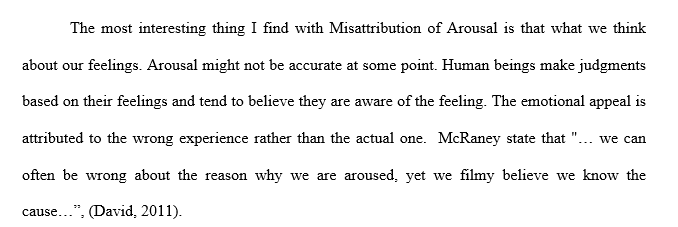What did you find most interesting about the Misattribution of Arousal? Explain in detail what struck you as interesting. Point to examples in
According to the author, David McRaney, in “The Misattribution of Arousal,” this particular thinking phenomenon manifests during heightened states of emotional arousal, be it anxiety, fear, intense pleasure, etc. When we are in a heightened state of arousal, we tend to mistakenly identify the cause of our arousal (for example, the men on the bridge in the article who assume they were attracted to the woman giving the questionnaire. They were really just scared of the high bridge, but the story they told themselves was their arousal was attributed to the woman, in essence denying their own fear by making up a story about romance and attraction). The strange thing that occurs in The Misattribution of Arousal is that we can often be wrong about the reason why we are aroused, yet we firmly believe we know the cause of our arousal. As the author notes, we often “experience emotional states without knowing why.” What actually happens—the “misattribution” part—is that rather sit with the ambiguity of not knowing why we feel aroused, we seize upon a cause and knit it into a narrative justifying our assumption. It would seem rational that we always know why we are aroused. However, as outlined in the article’s presentation of psychological studies, the exact opposite is true. We tend invent a cause to our arousal, regardless of how true it might be. We prefer to know any plausible story of why (even if untrue) rather than sit with uncertainty. In fact, it seems that this uncertainty as to why we might be aroused is so uncomfortable that we do not care, on a near unconscious level, that our story is probably wrong.
What is interesting about this odd human tendency to believe anything over sitting with ambiguity is that it has the potential for positive outcomes. As noted in the article, partnerships can benefit from Misattribution of Arousal. McRaney details how a marriage can be strengthened not by simply being together a lot, but by tackling challenging projects together. Because a challenge can give rise to various types of arousal (fear, worry, joy of completion, etc), this can have an effect of perceiving one’s partner as more attractive, more desirable, their attractiveness and desirability attributed not intrinsically being present, but because the arousal states cause the partners to invent positive characteristics about each other, whether they be true or not! ANSWER THE FOLLOWING QUESTIONS IN YOUR POSTING:
What did you find most interesting about the Misattribution of Arousal? Explain in detail what struck you as interesting. Point to examples in the reading to illuminate your answer. Where have you experienced Misattribution of Arousal occurring? Explain the circumstances of experiencing The Misattribution of Arousal. The author suggests that Misattribution of Arousal, though based on falsely attributing a cause to an effect, can have positive effects. What might be a scenario in which Misattribution of Arousal can have positive effects for people? How can a person use Misattribution of Arousal to his or her own benefit? Review the article for possible reflection. Be specific as to what a person can do to apply this phenomenon of human thinking.
Answer preview for What did you find most interesting about the Misattribution of Arousal? Explain in detail what struck you as interesting. Point to examples in

APA
300 Words